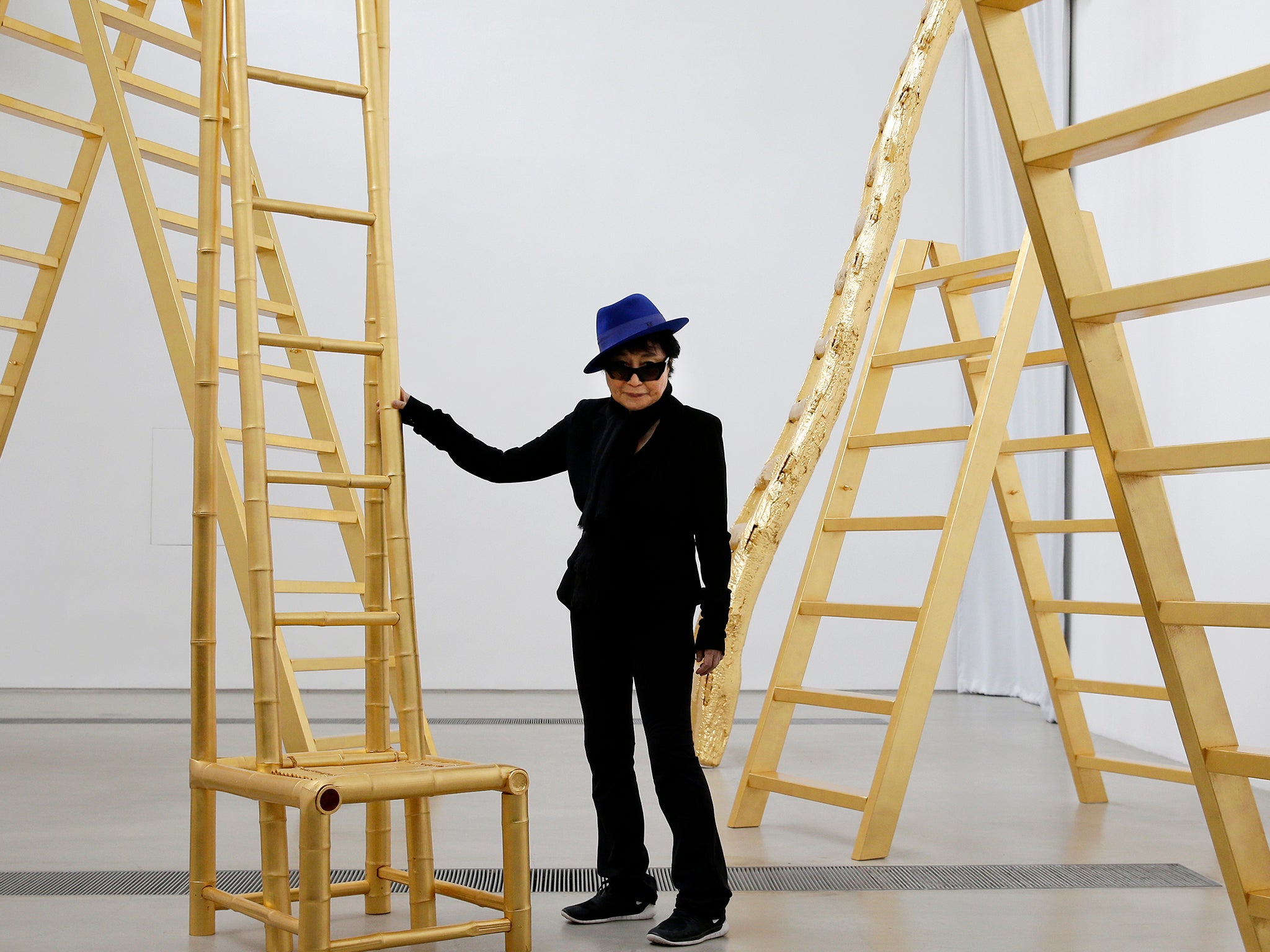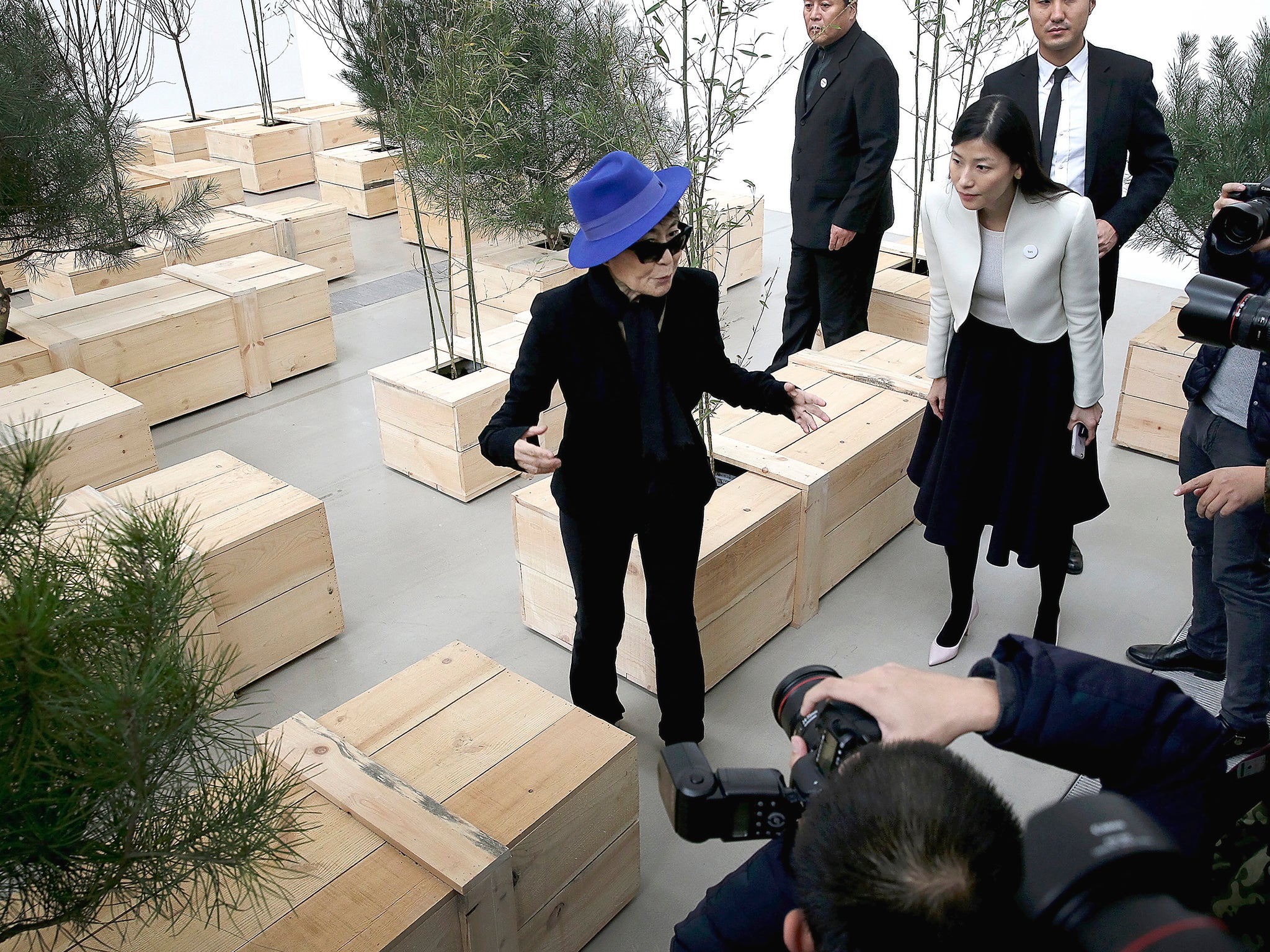Yoko Ono’s first solo exhibition in Beijing opens - but she avoids criticising Chinese state oppression
Ono’s exhibition opens at a time of artistic oppression in China

The opening of Yoko Ono’s first solo exhibition in Beijing began with 90 seconds of screeching, followed by the bemused, gentle applause of her audience.
“Today I came here so you can hear the voice of a woman,” the Japanese artist and widow of John Lennon told journalists in the East Hotel before unleashing a spew of howling and laughing.
Ono, 82, was in the Chinese capital to launch Golden Ladders, her major exhibition at the Faurschou Foundation gallery in the nearby 798 Art Zone. Running until July, the exhibition features a mix of old and new works, from the titular collection of gold-painted ladders to “Ex It”, a collection of coffins with trees protruding from them, originally made in 1997. Another piece is in the bathroom next to the lavatory: a black and white poster of some bare buttocks the public is invited to daub with graffiti.
Ono, flanked by the curator Jon Hendricks (mistakenly introduced by the host as John Lennon to much laughter), last exhibited solo in China in 2008, in Shanghai. Around that trip she talked about being nervous because of the long history of animosity between Japan and China, and she was keen to spread her message of peace and love.

Relations between the two countries have been particularly fraught recently, amid sea territory disagreements and the run-up to Beijing’s September military parade.
“Japanese, Chinese, all are very intelligent people,” Ono said, sporting a purple Boy George trilby hat and Dame Edna Everage sunglasses. “Instead of using their intelligence to fight each other it’s better to get together. I don’t think the world wants that [Sino-Japanese harmony], the world wants us to always be fighting so we are weak. But we have to know that they are trying to trick us.”
The Faurschou Foundation’s gallery in Copenhagen has previously hosted work by China’s persecuted dissident artist Ai Weiwei, and Ono’s exhibition opens at a time of artistic oppression in China.
President Xi Jinping said last year that Chinese art should promote socialism, and in an echo of Mao Tse-tung the state general administration of press, publication, radio, film and TV threatened to send artists to the countryside to “form a correct view of art”.
Questions to Ono from the Chinese state media predictably left this subject untouched. She did, however, field a question from The Independent on Sunday about her thoughts on China’s “feminist five” rights activists, who were arrested by the authorities in March for “picking quarrels and provoking trouble” after planning a multi-city protest against sexual harassment on public transport.
Perhaps understandably for a foreign artist kicking off a long-running exhibition in China, she was not ready to shout about activism in a country where the clamp on freedom of speech is being tightened daily. “Whatever the government is doing, it’s useless to criticise the government,” she said.
“The government are people too, they have so much red tape, they can’t do very much. People are the ones who can do things, people have to know that. It [challenging authorities] is not helping at all. Especially don’t pick up [on] certain items, certain things that are going on, and say, ‘Well, what do you think?’ I’m not going to say anything about it because it’s pointless to criticise people.
“It’s a very old idea: ‘Don’t criticise, just accept it, then it’s going to be all right.’ I hope you understand.”
Interrupting the conference host and peering over her glasses at her British questioner with a “this isn’t that easy” stare, she added: “It’s very Asian thinking. I said Asian thinking but I don’t mean to criticise Asian thinking, it’s the highest way of doing things. To not waste your time by criticising people because, actually, you don’t really know what you’re talking about.”
Then someone asked a question about the inspiration behind her art, the sunglasses went back up and all was calm again.
Join our commenting forum
Join thought-provoking conversations, follow other Independent readers and see their replies
Comments